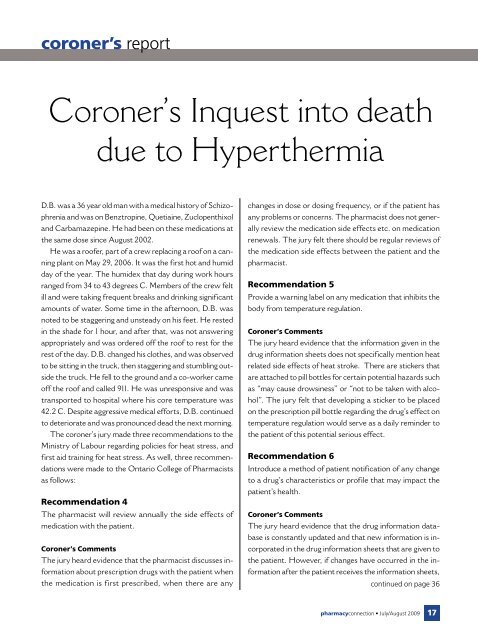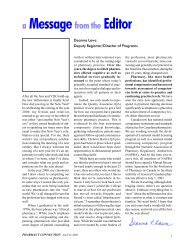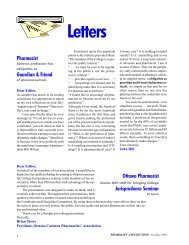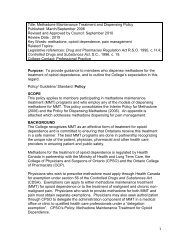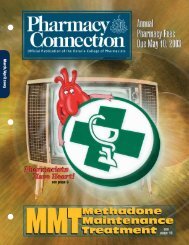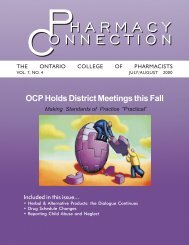Understand the Culture in Which You Practise Hyperthermia: Are ...
Understand the Culture in Which You Practise Hyperthermia: Are ...
Understand the Culture in Which You Practise Hyperthermia: Are ...
You also want an ePaper? Increase the reach of your titles
YUMPU automatically turns print PDFs into web optimized ePapers that Google loves.
coroner’s report<br />
Coroner’s Inquest <strong>in</strong>to death<br />
due to Hyper<strong>the</strong>rmia<br />
D.B. was a 36 year old man with a medical history of Schizophrenia<br />
and was on Benztrop<strong>in</strong>e, Quetia<strong>in</strong>e, Zuclopenthixol<br />
and Carbamazep<strong>in</strong>e. He had been on <strong>the</strong>se medications at<br />
<strong>the</strong> same dose s<strong>in</strong>ce August 2002.<br />
He was a roofer, part of a crew replac<strong>in</strong>g a roof on a cann<strong>in</strong>g<br />
plant on May 29, 2006. It was <strong>the</strong> first hot and humid<br />
day of <strong>the</strong> year. The humidex that day dur<strong>in</strong>g work hours<br />
ranged from 34 to 43 degrees C. Members of <strong>the</strong> crew felt<br />
ill and were tak<strong>in</strong>g frequent breaks and dr<strong>in</strong>k<strong>in</strong>g significant<br />
amounts of water. Some time <strong>in</strong> <strong>the</strong> afternoon, D.B. was<br />
noted to be stagger<strong>in</strong>g and unsteady on his feet. He rested<br />
<strong>in</strong> <strong>the</strong> shade for 1 hour, and after that, was not answer<strong>in</strong>g<br />
appropriately and was ordered off <strong>the</strong> roof to rest for <strong>the</strong><br />
rest of <strong>the</strong> day. D.B. changed his clo<strong>the</strong>s, and was observed<br />
to be sitt<strong>in</strong>g <strong>in</strong> <strong>the</strong> truck, <strong>the</strong>n stagger<strong>in</strong>g and stumbl<strong>in</strong>g outside<br />
<strong>the</strong> truck. He fell to <strong>the</strong> ground and a co-worker came<br />
off <strong>the</strong> roof and called 911. He was unresponsive and was<br />
transported to hospital where his core temperature was<br />
42.2 C. Despite aggressive medical efforts, D.B. cont<strong>in</strong>ued<br />
to deteriorate and was pronounced dead <strong>the</strong> next morn<strong>in</strong>g.<br />
The coroner’s jury made three recommendations to <strong>the</strong><br />
M<strong>in</strong>istry of Labour regard<strong>in</strong>g policies for heat stress, and<br />
first aid tra<strong>in</strong><strong>in</strong>g for heat stress. As well, three recommendations<br />
were made to <strong>the</strong> Ontario College of Pharmacists<br />
as follows:<br />
Recommendation 4<br />
The pharmacist will review annually <strong>the</strong> side effects of<br />
medication with <strong>the</strong> patient.<br />
Coroner’s Comments<br />
The jury heard evidence that <strong>the</strong> pharmacist discusses <strong>in</strong>formation<br />
about prescription drugs with <strong>the</strong> patient when<br />
<strong>the</strong> medication is first prescribed, when <strong>the</strong>re are any<br />
changes <strong>in</strong> dose or dos<strong>in</strong>g frequency, or if <strong>the</strong> patient has<br />
any problems or concerns. The pharmacist does not generally<br />
review <strong>the</strong> medication side effects etc. on medication<br />
renewals. The jury felt <strong>the</strong>re should be regular reviews of<br />
<strong>the</strong> medication side effects between <strong>the</strong> patient and <strong>the</strong><br />
pharmacist.<br />
Recommendation 5<br />
Provide a warn<strong>in</strong>g label on any medication that <strong>in</strong>hibits <strong>the</strong><br />
body from temperature regulation.<br />
Coroner’s Comments<br />
The jury heard evidence that <strong>the</strong> <strong>in</strong>formation given <strong>in</strong> <strong>the</strong><br />
drug <strong>in</strong>formation sheets does not specifically mention heat<br />
related side effects of heat stroke. There are stickers that<br />
are attached to pill bottles for certa<strong>in</strong> potential hazards such<br />
as “may cause drows<strong>in</strong>ess” or “not to be taken with alcohol”.<br />
The jury felt that develop<strong>in</strong>g a sticker to be placed<br />
on <strong>the</strong> prescription pill bottle regard<strong>in</strong>g <strong>the</strong> drug’s effect on<br />
temperature regulation would serve as a daily rem<strong>in</strong>der to<br />
<strong>the</strong> patient of this potential serious effect.<br />
Recommendation 6<br />
Introduce a method of patient notification of any change<br />
to a drug’s characteristics or profile that may impact <strong>the</strong><br />
patient’s health.<br />
Coroner’s Comments<br />
The jury heard evidence that <strong>the</strong> drug <strong>in</strong>formation database<br />
is constantly updated and that new <strong>in</strong>formation is <strong>in</strong>corporated<br />
<strong>in</strong> <strong>the</strong> drug <strong>in</strong>formation sheets that are given to<br />
<strong>the</strong> patient. However, if changes have occurred <strong>in</strong> <strong>the</strong> <strong>in</strong>formation<br />
after <strong>the</strong> patient receives <strong>the</strong> <strong>in</strong>formation sheets,<br />
cont<strong>in</strong>ued on page 36<br />
pharmacyconnection • July/August 2009<br />
17


